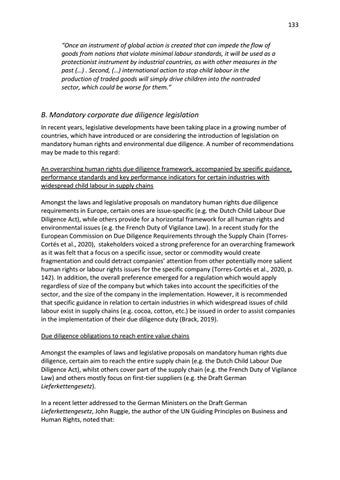133 “Once an instrument of global action is created that can impede the flow of goods from nations that violate minimal labour standards, it will be used as a protectionist instrument by industrial countries, as with other measures in the past (…) . Second, (…) international action to stop child labour in the production of traded goods will simply drive children into the nontraded sector, which could be worse for them.”
B. Mandatory corporate due diligence legislation In recent years, legislative developments have been taking place in a growing number of countries, which have introduced or are considering the introduction of legislation on mandatory human rights and environmental due diligence. A number of recommendations may be made to this regard: An overarching human rights due diligence framework, accompanied by specific guidance, performance standards and key performance indicators for certain industries with widespread child labour in supply chains Amongst the laws and legislative proposals on mandatory human rights due diligence requirements in Europe, certain ones are issue-specific (e.g. the Dutch Child Labour Due Diligence Act), while others provide for a horizontal framework for all human rights and environmental issues (e.g. the French Duty of Vigilance Law). In a recent study for the European Commission on Due Diligence Requirements through the Supply Chain (TorresCortés et al., 2020), stakeholders voiced a strong preference for an overarching framework as it was felt that a focus on a specific issue, sector or commodity would create fragmentation and could detract companies’ attention from other potentially more salient human rights or labour rights issues for the specific company (Torres-Cortés et al., 2020, p. 142). In addition, the overall preference emerged for a regulation which would apply regardless of size of the company but which takes into account the specificities of the sector, and the size of the company in the implementation. However, it is recommended that specific guidance in relation to certain industries in which widespread issues of child labour exist in supply chains (e.g. cocoa, cotton, etc.) be issued in order to assist companies in the implementation of their due diligence duty (Brack, 2019). Due diligence obligations to reach entire value chains Amongst the examples of laws and legislative proposals on mandatory human rights due diligence, certain aim to reach the entire supply chain (e.g. the Dutch Child Labour Due Diligence Act), whilst others cover part of the supply chain (e.g. the French Duty of Vigilance Law) and others mostly focus on first-tier suppliers (e.g. the Draft German Lieferkettengesetz). In a recent letter addressed to the German Ministers on the Draft German Lieferkettengesetz, John Ruggie, the author of the UN Guiding Principles on Business and Human Rights, noted that:













